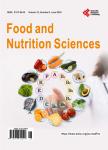Fermentation Patterns of Various Pectin Sources by Human Fecal Microbiota
Fermentation Patterns of Various Pectin Sources by Human Fecal Microbiota作者机构:Department of Food Science University of Arkansas Fayetteville USA Center for Food Safety University of Arkansas Fayetteville USA
出 版 物:《Food and Nutrition Sciences》 (食品与营养科学(英文))
年 卷 期:2015年第6卷第12期
页 面:1103-1114页
学科分类:1002[医学-临床医学] 100214[医学-肿瘤学] 10[医学]
主 题:Short-Chain Fatty Acids Soy Pectin Denaturing Gradient Gel Electrophoresis
摘 要:High Methoxy Pectin (HMP), Sugar Beet Pectin (SBP), Soy Pectin (SOY), and Fructooligosaccharide (FOS, as a positive control) were used to determine fermentation properties considering applicabil-ity as functional foods, particularly related to colon health. Certain beneficial effects of carbohy-drates in humans can be postulated as being due to microorganisms and metabolites (short-chain fatty acids (SCFAs)). Fecal samples were collected and incubated anaerobically with HMP, SBP, SOY, and FOS at 37 °C. The average degree of polymerization (DP) of HMP, SBP, and SOY was 492, 3729, and 1510, respectively. Degree of pectin methylation of each sample was 76.0% (HMP), 21.2% (SBP), and 22.8% (SOY). Total SCFAs in SOY showed the highest value compared to other samples, especially having the highest concentration of propionic acid (P 0.05). While fermentation with FOS showed higher butyrate production, the total SCFAs with SOY, HMP, and SBP were significantly higher than FOS over 30 h (P 0.05). From the denaturing gradient gel electrophoresis (DGGE) analysis, changes of microbiota composition were found. In conclusion, pectin samples, especially soy pectin, stimulated production of total SCFAs and composition of human fecal microbiota was modulated. Therefore, pectin samples may alter the composition of fecal microbiota and improve the colonic health.



